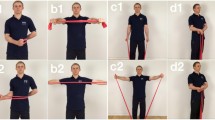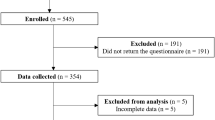Abstract
Purpose
Unfavorable psychosocial working conditions are hypothesized to lead to perceived stress, which, in turn, can be related to an increased risk of development of neck/shoulder symptoms through increased and sustained muscle activation. The aim of the present study was to test this hypothesized process model among medical secretaries, a female-dominated profession characterized by a high amount of visual display unit use and a high prevalence of neck/shoulder symptoms.
Methods
In this cross-sectional study, a questionnaire survey was conducted among medical secretaries (n = 200). The proposed process model was tested using a path model framework.
Results
The results indicate that high work demands were related to high perceived stress, which in turn was related to a high perceived muscle tension and neck/shoulder symptoms. Low influence at work was not related to perceived stress, but was directly related to a high perceived muscle tension.
Conclusions
In general, these cross-sectional results lend tentative support for the hypothesis that adverse psychosocial work conditions (high work demands) may contribute to the development of neck/shoulder symptoms through the mechanism of stress-induced sustained muscular activation. This process model needs to be further tested in longitudinal studies.


Similar content being viewed by others
References
Aarås A, Horgen G, Ro O (2000) Work with the visual display unit: health consequences. Int J Hum Comput Interact 12:107–134
Ariens G, van Mechelen W, Bongers P, Bouter L, van der Wal G (2001) Psychosocial risk factors for neck pain: a systematic review. Am J Ind Med 39:180–193
Bongers P, de Winter C, Kompier M, Hildebrandt V (1993) Psychosocial factors at work and musculoskeletal disease. Scand J Work Environ Health 19:297–312
Bongers PM, Ijmker S, van den Heuvel S, Blatter BM (2006) Epidemiology of work related neck and upper limb problems: psychosocial and personal risk factors (Part I) and effective interventions from a bio behavioural perspective (Part II). J Occup Rehabil 16:279–302
Byström P, Johansson Hanse J, Kjellberg A (2004) Appraised psychological workload, musculoskeletal symptoms, and the mediating effect of fatigue: a structural equation modeling approach. Scand J Psychol 45:331–341
Christensen H, Lundberg U (2002) Musculoskeletal problems as a result of work organization, work tasks and stress during computer work. Work Stress 16:89–93
Faucett J (2005) Integrating ‘psychosocial’ factors into a theoretical model for work-related musculoskeletal disorders. Theor Issues Ergon Sci 6:531–550
Hägg G (1991) Static work loads and occupational myalgia—a new explanation model. In: Andersson PA, Hobart DJ, Danoff JV (eds) Electromyographical Kinesiology. International Congress series, vol 949. Elsevier, Amsterdam
Hägg G, Åström A (1997) Load pattern and pressure pain threshold in the upper trapezius muscle and psychosocial factors in medical secretaries with and without shoulder/neck disorders. Int Arch Occup Environ Health 69:423–432
Hamberg-van Reenen HH, van der Beek AJ, Blatter BM, van der Grinten MP, van Mechelen W, Bongers PM (2008) Does musculoskeletal discomfort at work predict future musculoskeletal pain? Ergonomics 51:637–648
Herrting A, Nilsson K, Theorell T, Sätterlund Larsson U (2003) Personnel reductions and structural changes in health care. Work-life experiences of medical secretaries. J Psychosom Res 54:161–170
Holte KA, Westgaard RH (2002) Daytime trapezius muscle activity and shoulder-neck pain of service workers with work stress and low biomechanical exposure. Am J Ind Med 41:393–405
Hoogendoorn WE, van Poppel MNM, Bongers PM, Koes BW, Bouter LM (2000) Systematic review of psychosocial factors at work and private life as risk factors for back pain. Spine 25:2114–2125
Jensen C, Ryholt CU, Burr H, Villadsen E, Christensen H (2002) Work-related psychosocial, physical and individual factors associated with musculoskeletal symptoms in computer users. Work Stress 16:107–120
Karasek RA (1979) Job demands, job decision latitude, and mental strain: implications for job redesign. Adm Sci Q 24:285–309
Kjellberg A, Iwanowski S (1989) Stress/energi-formuläret: utveckling av en metod för skattning av sinnesstämning i arbetet. Undersökningsrapport 1989:26. Arbetslivsinstitutet, Solna (Sweden) (in Swedish)
Kjellberg A, Wadman C (2002) Subjektiv stress och dess samband med psykosociala förhållanden och besvär: En prövning av Stress-Energi-modellen. Arbete och Hälsa 2002:12. Arbetslivsinstitutet, Solna (Sweden) (in Swedish)
Kjellberg A, Johansson Hanse J, Franzon H, Holmgren C (2000) Mood ratings at work and job strain and their relation to neck and shoulder symptoms. In: Proceedings of the 14th triennial congress of the international ergonomics association and 44th annual meeting of the human factors and ergonomics society, San Diego
Kline RB (1998) Principles and practice of structural equation modeling. The Guilford Press, New York
Kristensen TS, Borg V, Hannerz H (2002) Socioeconomic status and psychosocial work environment: results from a Danish national study. Scand J Public Health 30:41–48
Larsman P, Sandsjö L, Klipstein A, Vollenbroek-Hutten M, Christensen H (2006) Perceived work demands, felt stress, and musculoskeletal symptoms among elderly female computer users. The NEW study. Eur J Appl Physiol 96:127–135
Larsman P, Thorn S, Søgaard K, Sandsjö L, Sjøgaard G, Kadefors R (2009) Work related perceived stress and muscle activity during standardized computer work among female computer users. Work 32:189–199
Larsman P, Lindegård A, Ahlborg Jr G (2011) Longitudinal relations between psychosocial work environment, stress and the development of musculoskeletal pain. Stress Health 27:e228–e237
Linton SJ, Kamwendo K (1989) Risk factors in the psychosocial work environment for neck and shoulder pain in secretaries. J Occup Med 31:609–613
Lundberg U (2002) Psychophysiology of work: stress, gender, endocrine response, and work-related upper extremity disorders. Am J Ind Med 41:383–392
Lundberg U, Kadefors R, Melin B, Palmerud G, Hassmén P, Engström M, Elfsberg Dohns I (1994) Psychophysiological stress and EMG activity of the trapezius muscle. Int J Behav Med 1:354–370
McLean L, Urquhart N (2002) The influence of psychological stressors on myoelectrical signal activity in the shoulder region during a data entry task. Work Stress 16:138–153
Melin B, Lundberg U (1997) A biopsychosocial approach to work-stress and musculoskeletal disorders. J Psychophysiol 11:238–247
Miranda H, Viikari-Juntura E, Martikainen R, Takala EP, Riihimäki H (2001) A prospective study of work related factors and physical exercise as predictors of shoulder pain. Occup Environ Med 58:528–534
Nahit ES, Hunt IM, Lunt M, Dunn G, Silman AJ, Macfarlane GJ (2003) Effects of psychosocial and individual psychological factors on the onset of musculoskeletal pain: common and site-specific effects. Ann Rheum Dis 62:755–760
NIOSH (1997) Musculoskeletal disorders and workplace factors. A critical review of epidemiologic evidence for work-related musculoskeletal disorders of the neck, upper extremity, and low back. NIOSH Publication No. 97-141. Department of Health and Human Services, Public Health Service, Centers for Disease Control and Prevention, Cincinnati, USA
Polanyi MFD, Cole DC, Beaton DE, Chung J, Wells R, Abdolell M, Beech-Hawley L, Ferrier SE, Mondloch MV, Shields SA, Smith JM, Shannon HS (1997) Upper limb work-related musculoskeletal disorders among newspaper employees: cross-sectional survey results. Am J Ind Med 32:620–628
Rugulies R, Aust B, Siegrist J, von dem Knesebeck O, Bültmann U, Bjorner J, Burr H (2009) Distribution of effort-reward imbalance in Denmark and its prospective association with a decline in self-rated health. J Occup Environ Med 51:870–878
Sandsjö L, Wahlström J, Grundell L, Larsman P, Kadefors R (2006) Myofeedback experiences in female computer users reporting muscular tension in the neck/shoulder. In: Proceedings of the IEA 2006
Sauter SL, Swanson NG (1996) An ecological model of musculoskeletal disorders in office work. In: Moon SD, Sauter SL (eds) Beyond biomechanics. Psychosocial aspects of musculoskeletal disorders in office work. Taylor & Francis, London, pp 3–21
Sjøgaard G, Lundberg U, Kadefors R (2000) The role of muscle activity and mental load in the development of pain and degenerative processes on the muscle cell level during computer work. Eur J Appl Physiol 83:99–105
Swedish Work Environment Authority and Statistics Sweden (2003) Ensidigt upprepat arbete. Arbetsmiljöförhållanden, besvär, sjukfrånvaro, sjuknärvaro (Repetitive work. Work environment, work-related disorders, sick leave due to work-related disorders, work despite sickness). Information om utbildning och arbetsmarknad (Information on education and the labour market) 2003:4, Work Environment Authority and Statistics Sweden, Stockholm
Theorell T, Harms-Ringdahl K, Ahlberg-Hultén G, Westin B (1991) Psychosocial job factors and symptoms from the locomotor system—a multicausal analysis. Scan J Rehabil Med 23:165–173
Thorn S, Søgaard K, Kallenberg LAC, Sandsjö L, Sjøgaard G, Hermens HJ, Kadefors R, Forsman M (2007) Trapezius muscle rest time during standardized computer work—a comparison of female computer users with and without self-reported neck/shoulder complaints. J Electromyogr Kinesiol 17:420–427
Vasseljen O, Holte KA, Westgaard RH (2001) Shoulder and neck complaints in customer relations: individual risk factors and perceived exposures at work. Ergonomics 44:355–372
Veiersted KB, Westgaard RH, Andersen P (1993) Electromyographic evaluation of muscular work pattern as a predictor of trapezius myalgia. Scand J Work Environ Health 67:11–18
Viikari-Juntura E, Maritkainen R, Luukkonen R, Mutanen P, Takala H, Riihimäki H (2001) Longitudinal study on work related and individual risk factors affecting radiating neck pain. Occup Environ Med 58:345–352
Wahlström J (2003) Physical load, psychosocial and individual factors in visual display unit work. Arbete och Hälsa. Arbetslivsinstitutet, Stockholm
Wahlström J, Lindegård A, Ahlborg G Jr, Ekman A, Hagberg M (2003) Perceived muscular tension, emotional stress, psychological demands and physical load during VDU work. Int Arch Occup Environ Health 76:584–590
Wahlström J, Hagberg M, Toomingas A, Wigaeus Tornqvist E (2004) Perceived muscular tension, job strain, physical exposure, and associations with neck pain among VDU users; a prospective cohort study. Occup Environ Med 61:523–528
Westgaard RH (1999) Effects of physical and mental stressors on muscle pain. Scand J Work Environ Health 25:19–24
Acknowledgments
The authors thank Christer Knutsson at “Hälsan och arbetslivet” and Agneta Lindegård at the Institute for Stress Medicine for their contribution to this study. This study was supported by Region Västra Götaland, Sweden, and AFA Insurance, Sweden (grant number FA-11:02). Dr. Larsman was supported by a postdoc grant from the Swedish Council for Working Life and Social Research (grant number 2007-0655). Dr. Sandsjö was supported by the European Union via Tillväxtverket and the Regional Development Fund.
Conflict of interest
The authors declare that they have no conflict of interest.
Author information
Authors and Affiliations
Corresponding author
Rights and permissions
About this article
Cite this article
Larsman, P., Kadefors, R. & Sandsjö, L. Psychosocial work conditions, perceived stress, perceived muscular tension, and neck/shoulder symptoms among medical secretaries. Int Arch Occup Environ Health 86, 57–63 (2013). https://doi.org/10.1007/s00420-012-0744-x
Received:
Accepted:
Published:
Issue Date:
DOI: https://doi.org/10.1007/s00420-012-0744-x




